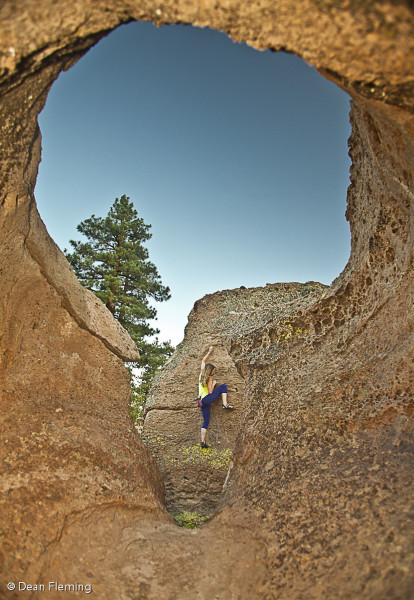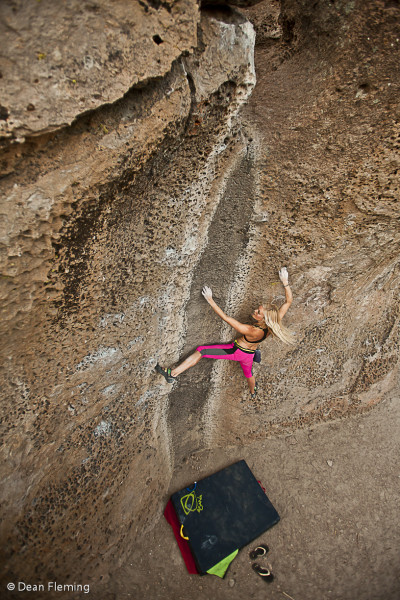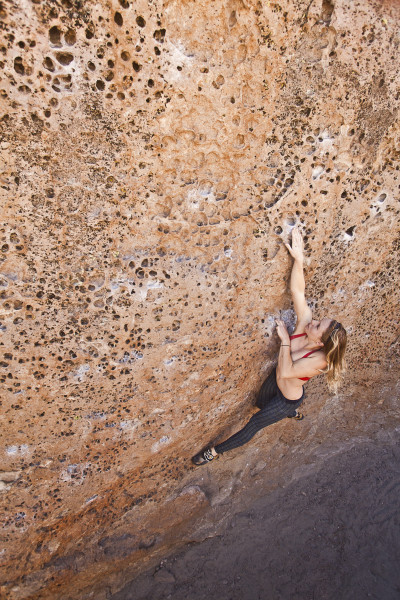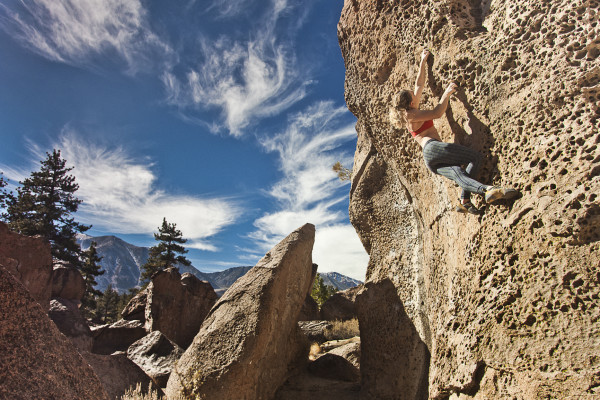Below the southern reaches of Crowley Lake, between Highway 395 and the northernmost portion of the Owen’s River Gorge, a series of well-kept forest service roads lead into the remarkable landscape of the Sherwin Plateau. Almost all of the profoundly featured volcanic rock on the plateau appears to be climbable, and much of it has been climbed, but the areas with the steepest walls and most striking features are often hidden within the drainages of rarely formed waterways. At a small but particularly remarkable sector known as the Dreamers, prominent black water streaks descend down vibrant walls of heavily pocketed stone. Here, it is not the holds that dictate the beauty and presence of the lines, it is the unusual shapes and colors of the sculpted walls that draw climbers to chalk up and explore.

Bouldering in California’s Eastern Sierra has captivated climbers for generations. Since the days of Yosemite’s Golden Era, nomadic climbers have made the short drive from the formidable granite peaks of the High Sierra and Tuolumne Meadows to the temperate basins of the Eastside; a place where hundreds of miles of pine-swept plateaus are dotted with pocketed blocks and small volcanic cliff-bands.
In the 1970s and early 1980s, these areas were visited and re-visited by some of the most iconic names in California climbing history. Yet perhaps the greatest developments in the region have been made by a handful of reticent climbers; relatively silent visitors who spent countless hours wandering the dusty forests in search of unclimbed rock. Many of the Eastern Sierra’s earliest boulderers left their achievements undocumented and their first ascents un-named.
As a teenager in the mid-1970s Touchstone member Dave Yerian spent the better part of a decade hitchhiking up and down Highway 395 and exploring the expansive pockets of volcanic boulders along the way. Dave soon joined up with folks like Errett Allen, Scott Cole, Shawn Plunkett, John Bachar, Kevin Leary and Ron Kauk who were also scouring the area for new routes near the turn of the decade.
“Both the bouldering and the solitude drew me to the Eastside,” said Yerian. “We were motivated by finding new things; good rock and new areas. The Eastside had all of those elements. I just didn’t dig the crowds – and I figured I would climb at my best when I wasn’t around them. John Gill was our God. We’d drive back roads for hours to find solitude like Gill.”
In the 1970s bouldering was largely considered a training regime; a tool used to acquire physical and mental strength for harder free climbing on larger walls. While bouldering 5.12 (or V4) is not considered especially difficult by today’s standards, many of the earliest boulder problems established on the Eastside include extremely technical and tedious 5.12 moves at heights up to 45 feet.
“Bouldering was different back then,” said Yerian. “We didn’t have crashpads – a dish towel to clean your shoes was state-of-the-art. It would be a huge mistake if we fell off a highball. We pretty much relied on ourselves, which made bouldering an enticing risk. You had to really train hard and have a little luck going for you… or have the smarts to just say no.”
Over the last four decades, bouldering has steadily transformed from a pastime to a passion. In equal measure, the Eastern Sierra’s boulder fields have become Meccas for climbers around the globe. “Bouldering didn’t mean a lot to people back then, but some of us knew that it would,” added Yerian. “I’m not claiming that we were visionaries or anything, but we were motivated.”
Although the bouldering areas south of Crowley Lake at the Sherwin Plateau are often regarded for providing high-quality moderate boulder problems and hassle-free camping, the region still remains largely quite; especially in comparison to high-traffic areas like the Happy Boulders and Buttermilks to the south. As a testament to the introverts who camped, climbed, drank cheap beer and rambled about the otherwise deserted landscape between Mono Lake and Bishop, pockets of un-crowded boulders remain overshadowed and overlooked. Never-the-less, for those who enjoy beautiful natural lines in pristine wilderness areas, largely-forgotten sectors in the Sherwin Plateau like the Dreamers are making a quick comeback.

The majority of the boulder problems at the Dreamers fall between V0 and V3. The hardest climbs at the area check in around V5. So if you’re looking for your next double-digit project, you’ll have to look somewhere else. But if you’re interested in running some circuits on beautifully tall and striking moderates, the Dreamers are well worth an afternoon visit. There are approximately 50 independent problems in the small drainage. The 20-foot walls that surround the pit weave in and out of amazing water scoops and onto the prows of featured arêtes. This unique feature produces some very nice highballs, but also lends itself to incredibly long and interesting traversing problems.
Ambitious boulderers could likely climb the majority of the problems at the Dreamers in a single afternoon, but the scenery and short approach make the area well-suited for relaxing end-of-the-trip visits. Because the Sherwin Plateau sits at a significantly higher elevation than the Tableland bouldering areas in Bishop, the Dreamers can also be a great place to escape the heat in spring and fall.
DRIVING DIRECTIONS:
The Sherwin Plateau is easily spotted when driving north on Highway 395 from the town of Bishop. A large sign reading “Sherwin Summit” is clearly visible on the right (east) side of the highway. At the Sherwin Summit sign, turn east onto forest service road 4S43. After one, mile turn left onto forest service road 4S05. This road takes you into an open valley. After 1/2 mile turn right onto an unmarked dirt road which leads up a gradual hill. Follow this for 1/4 mile to the point where the road levels and park in a large pull-out on the left side of the road. The boulders can be easily seen just a few hundred yards beyond the pull-out.

WHERE TO STAY:
Make sure to check with the local ranger station to get information on current fire restrictions and permits before building a fire in the area.
TICKLIST:
Thimble of the High Sierra (V3)
Bourbon IV (V0)
Three Men and a Crippler (V2)
Flow-Bee (V0)
Mitosis (V0)
GUIDEBOOK:
Bishop Bouldering by Wills Young. Available in any Touchstone Climbing Pro Shop
Trip Report By Dean Fleming

